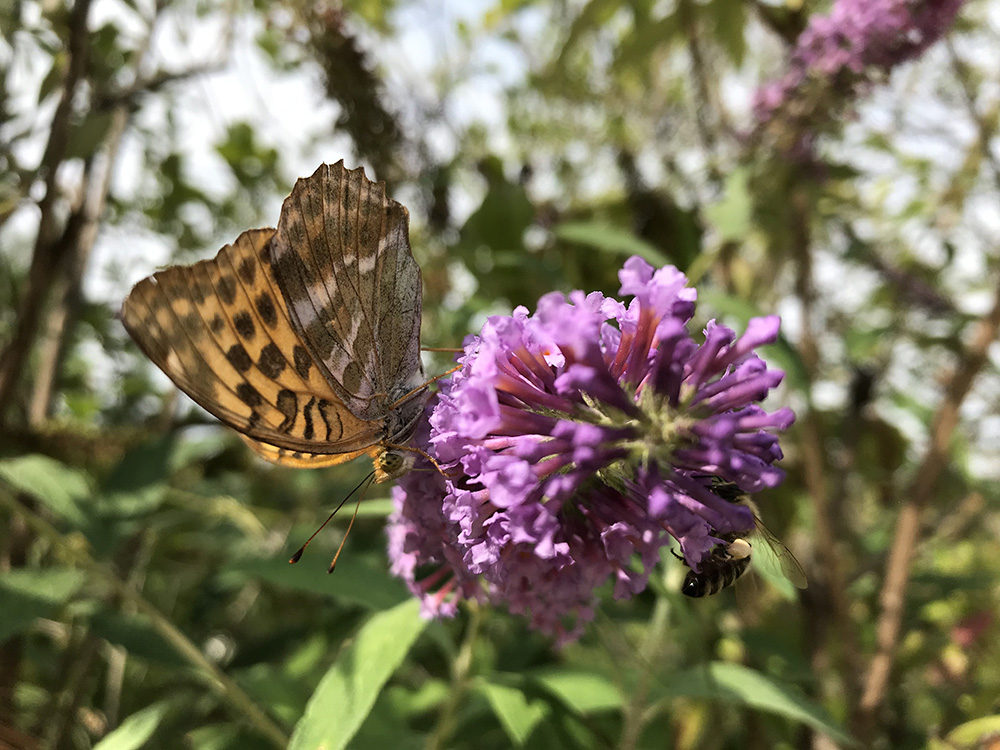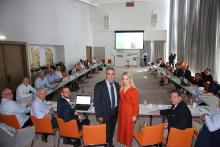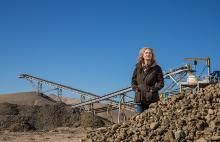
Dr. Monica Soldinger Almefelt stresses how introducing biodiversity to active and former quarry sites is not just nice to have; it could keep you in business.
“A biodiversity management plan is a requirement from authorities in many cases to obtain a quarry permit, which is worth several million kronor and forms the basis of our entire business. It is also increasingly important in tenders: if you do not win tenders, you do not get any jobs. If you have no jobs, you have no income. No income means no business.”
Almefelt, Swerock’s raw material manager for the past 12 years, who worked closely with the company seven years prior as a consultant, notes that healthy biodiversity on a quarry site is also good for relationships with customers, authorities, nearby residents and schools. It is also good, she believes, for attracting and retaining employees and good for company brand building.
 “There is increased environmental awareness both in society, leading to stricter legislation and practice, and within Swerock. It is easy to do things without it costing too much, and a greener focus represents a great opportunity for the aggregates industry. For example, biodiversity management plans for quarries are increasingly common yet were very unusual in Sweden 10 years ago.
“There is increased environmental awareness both in society, leading to stricter legislation and practice, and within Swerock. It is easy to do things without it costing too much, and a greener focus represents a great opportunity for the aggregates industry. For example, biodiversity management plans for quarries are increasingly common yet were very unusual in Sweden 10 years ago.
“The discovery of a lot of biological diversity in quarries and gravel pits, such as pollinating and insects and birds of prey, made site operators more aware of how their workplaces can offer varied habitats. They offer conditions rare in surrounding landscapes, which can typically be pine or spruce forests with very sparse biodiversity. Primary species particularly like quarry and gravel pit environments.”
Almefelt says the European Commission-led European Green Deal is an important step forward in delivering greater biodiversity. “It’s a package of measures that address several policy areas to enable a sustainable green transition and for Europe to become the first climate-neutral continent by 2050. The EU’s strategy for biodiversity 2030, published in May 2020, forms part of this. The aim is for Europe’s biodiversity to recover by 2030 and for all the world’s ecosystems by 2050 to be restored, resilient and adequately protected. The strategy will be implemented between 2021 and 2024.”
Almefelt is also heartened by ongoing negotiations, which will lead to a new global framework for biodiversity through the Convention on Biological Diversity (CBD). “The UN Conference of the Parties on CBD in China this October is expected to deliver a global agreement on countries’ commitments and actions on biodiversity, as the Paris Memorandum did for climate action.”
Asked about examples of Swerock’s quarry-biodiversity best practice, she proudly highlights that the company’s flagship quarry, Kållered, located just outside Gothenburg, received a Special Mention for Biodiversity in the 2019 UEPG Sustainable Development Awards. Almefelt, a 49-year-old Gothenburg native, collected the award on behalf of Swerock during a special awards presentation event in Brussels, Belgium.
“The Special Mention recognition generated a lot of media coverage in Sweden and construction industry magazines. It was really good to spread the word about what we’re doing at Swerock, including internally among the executive team.
“At Kållered quarry, which is one of the biggest quarries in Sweden, and the adjacent Sagsjön lake, a lot of work has been done to foster biodiversity. This has led to protected species moving in. For example, a peregrine falcon couple, sand martins and black redstarts nest in the quarry. The peregrine falcon couple alone has produced 18 chicks. This shows that it is possible to foster biodiversity while continuing with extraction in quarries.”
Almefelt project-managed a printed guide, Inspiration to create good nature in quarries. Measures during operation and in conjunction with rehabilitation. The publication was produced by Swerock and the environmental consultant firm Ecogain, in collaboration with other companies, the Swedish University of Agricultural Sciences and the County Administrative Board of Östergötland.
“The guide is adapted to Swedish conditions and with hands-on advice on how to foster biodiversity in practice. The guide won an SBUF (Swedish Construction Industry Development Fund) award for innovation of the year. It was also handed out by UEPG at EU Green week last year.”
Her role with Swerock has expanded and diversified in her 12 years with the company. “When I started here, I mainly worked with applications for quarry and gravel pit permits and environmental impact assessments in central Sweden, but after a couple of years, I was working all over Sweden and also with a few quarries based in other Nordic countries. The biggest difference for me personally, though, is that I now spend about half my time on research and development, which includes being involved in several networks and R&D projects.”
I ask Almefelt how the quarry permitting process has changed in the last decade. “It has become significantly more regulated, and processing times have become longer. In Sweden, you get a permit for a quarry in 20 years in the normal case, which means that I have started working with new permit applications for a few quarries I applied for when I started in this business. Back then, an application was typically 150 pages; now, they are up to 800 pages. Natural gravel and sand are now only allowed to be used for purposes where they cannot be replaced by crushed rock or recycled aggregates. This means that almost only new rock quarries are started, and natural gravel and sand pits are becoming fewer and fewer. It is positive that there is a much greater focus on, among other things, environment, biodiversity and climate.”
As part of her networks and R&D projects at Swerock, Almefelt is Sweden’s representative on the UEPG management board, a member of the association’s environment and technical committees, and part of the UEPG’s Biodiversity Task Force.
“A lot of work on how to achieve greater biodiversity in quarries and gravel pits is going on at UEPG level. Promoting biodiversity at these sites does not have to be complicated or expensive. It is largely a matter of not doing the wrong things, like removing a swallow nest during breeding season or putting fish or crayfish in sedimentation ponds that could otherwise have been suitable habitats for amphibians.
“A current development area is how to measure biological diversity, so you can see what effect the measures have. However, the biggest and most important task right now is to put all knowledge into practice, especially for SMEs [small and medium enterprises] with limited resources.
“My work with UEPG has helped me a lot in terms of identifying best practices on biodiversity and in other areas of the aggregates industry. Becoming better-informed means I can better influence decisions at a European level.”
There are imminent new requirements in the UK for ‘biodiversity net gain’, and the application of Defra’s (The Department for Environment, Food and Rural Affairs) latest ‘Biodiversity Metric 3.0’, a formula to be used in most planning applications to demonstrate a ‘biodiversity net gain’ of at least 10%.
The Mineral Products Association (MPA), the industry trade association for the aggregates, asphalt, cement, concrete, dimension stone, lime, mortar and silica sand industries, and the British Aggregates Association (BAA) say a metric is not needed. Both organisations have long campaigned for greater recognition that mineral extraction delivers net gain as a matter of course.
The MPA notes that being a temporary activity that occurs over many years, quarry sites are progressively restored post-mineral extraction, creating new habitats. The association has highlighted that the creation of some habitats, such as lakes, reedbeds, rock faces, and lowland heathland, is easier to achieve on mineral sites. Both the MPA and BAA fear that introducing a one-size-fits-all approach might encourage less, not more, habitat to be delivered.
The biodiversity net-gain requirement is one of the measures in the Environmental Bill that is currently progressing through parliament. Once enacted, biodiversity net gain will become a legal requirement for new development. The government says this is being introduced to address serious damage to wildlife resulting from some types of development, particularly housing.
I am curious to know what Almefelt thinks about the proposed biodiversity net-gain requirement in the UK quarrying industry. “I think metrics can show some results in the short term, but it takes a long time to measure whether there has been net gain from a long-term quarry restoration project. Metrics are not something we have used in the Swedish quarrying industry. It would require more administration, for sure. And what would be the baseline when it comes to biodiversity net gain?”
Having a longstanding and deep-rooted interest in quarrying processes, Almefelt has a PhD from Chalmers University of Technology in Gothenburg awarded for her impressive research on the screening of crushed rock material.
“The research objective was to develop a physical model that explains the behaviour of crushed material on a screen. The model was implemented in a computer program, after which a large number of full-scale tests verified its validity. Thus, it is possible to optimise a screening process concerning the percentage of over and undersized particles allowed by varying the frequency, stroke, inclination, length, width and aperture size of the screen, as well as the feed rate, feed size distribution and the number of interacting screen planes.”
Almefelt says Chalmers University of Technology’s research for the aggregates industry began in 1993. Since then, many doctoral students have continued their work in a variety of areas. “The first project was about modelling of cone crusher, mine on screens was the second. Following on has been research on air classification, VSI [vertical shaft impactor] crushing, replacement of natural sand and gravel with crushed rock material and modelling and optimisation of entire crushing plants. Now the simulations are also used to calculate environmental data as a basis for EPDs (Environmental Product Declaration) for rock material. In recent years, DEM (Discrete Element Method) has provided great opportunities for more advanced modelling.
“The university has a group called Chalmers Rock Processing Research which Swerock collaborates with. I am engaged in the steering and reference groups for some of the projects, and in these, they use some of the findings of my research work.”
Almefelt says Swerock, together with the IVL Swedish Environmental Research Institute and some other companies, has also contributed to important projects analysing the impact of quarry dust. One key study in this area is titled Measures regarding fugitive particulate emissions from construction and industrial processes and investigation of possible effects on vegetation of dusting from quarries.
Highlighting some of the current eye-catching research projects that she is involved with, Almefelt says: “The Development of a web-based EPD tool for rock material production is a large research project with several researchers at Chalmers University of Technology. I am also involved in a PhD research project at Chalmers covering the Optimisation of real processes for rock material production. Reducing Radon Gas Emissions in Concrete is a PhD project at KTH Royal Institute of Technology. Then there is the Changing Land-use Impact on Biodiversity (CLImB) development project run by Ecogain. I’m also involved in the Ecological and nature-based climate compensation innovation project run by Calluna, University of Gothenburg and others.”
 Asked to quantify the importance of R&D to the aggregates industry, Almefelt, who is on the society committee at SBMI, the Swedish Aggregates Producers Association, says: “It is extremely important in the environmental field. Electrification of quarries is also an important area that contributes to solving the climate issue. As there has historically been limited research in the aggregate industry compared to many other areas, there is great potential when it comes to streamlining and optimising production.”
Asked to quantify the importance of R&D to the aggregates industry, Almefelt, who is on the society committee at SBMI, the Swedish Aggregates Producers Association, says: “It is extremely important in the environmental field. Electrification of quarries is also an important area that contributes to solving the climate issue. As there has historically been limited research in the aggregate industry compared to many other areas, there is great potential when it comes to streamlining and optimising production.”
Touching on her work for SBMI, Almefelt says: “SBMI is a member of UEPG and monitors and influences what affects our aggregates industry nationally, while also responding to referrals from Swedish authorities. Current issues the SBMI is looking at include circular material handling, EoW (end-of-waste) criteria, biodiversity, electrification of crushing plants, working environments and permit processes.
“SBMI has also produced a roadmap for fossil-free competitiveness in the aggregates industry. And during a big SBMI seminar a few months ago, over 80% of more than 200 industry representatives in attendance voted to implement a biodiversity roadmap like the roadmap I was involved in for the Swedish mining industry as part of the Mining with nature project.”
So how does Almefelt see the Swedish and wider European aggregates industry in a decade’s time? “Part of the primary raw material will be replaced by recycled material, but it will only cover a part of the total need. The use of natural gravel and sand will gradually be phased out. Creating a sustainable aggregates industry is essential for the quality of life in and economy of Europe. I would also like all big European quarries, at least, to create biodiversity management plans that they make happen in reality.”
Married to Lars and a mother to a 16-year-old daughter and two grown-up stepsons, Almefelt enjoys horse riding, painting, travelling, and socialising with friends when not working. Unsurprisingly, given her work at Swerock and within UEPG, she also enjoys regular non-work-related nature experiences. “This July, I was horse riding in the Swedish mountains. Last summer, I did the same in Iceland. I also have great memories of horse riding in the Tien Shan mountains in Kyrgyzstan.
“It is also fun to go on safari. I’ve watched hummingbirds in Costa Rica, elephants in Botswana and glow worms in New Zealand. We also have a summer house in Sweden next to the sea. It’s nice to go swimming, out in our boat, and to walk in the forest.”
It will be very interesting to see how Almefelt’s obvious passion for quarry-site biodiversity and nature, in general, shapes her future R&D work and environmental advocacy at the heart of Europe with UEPG.










